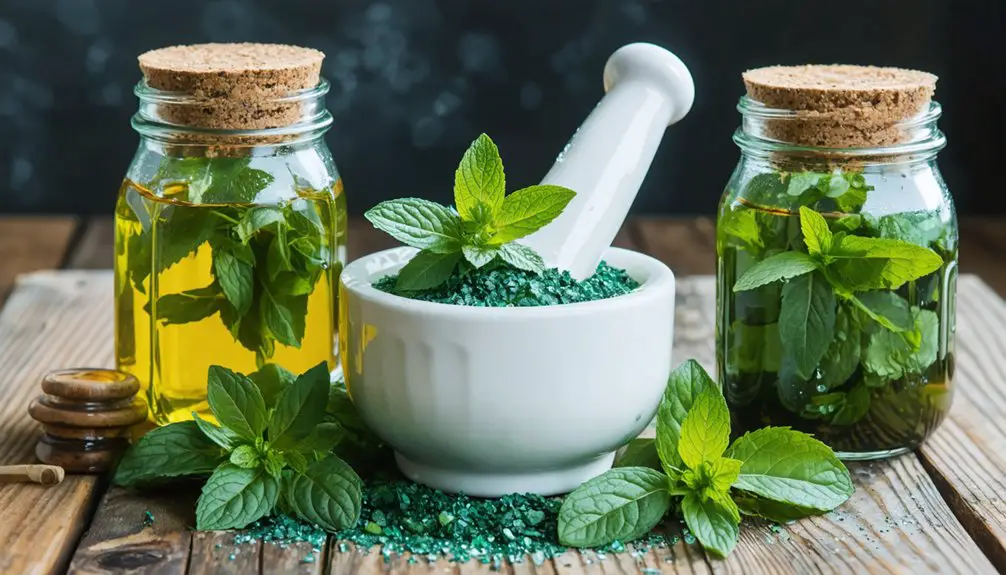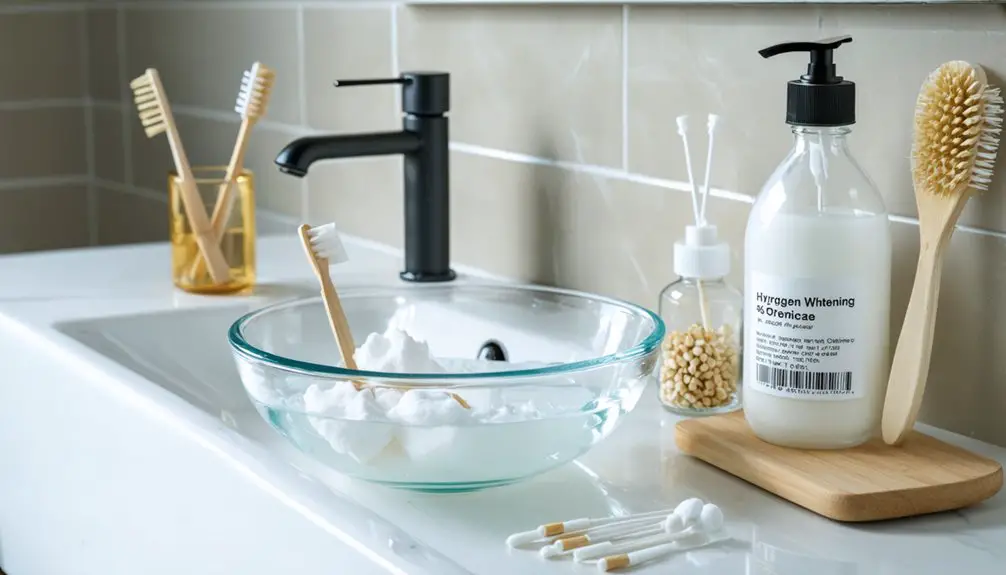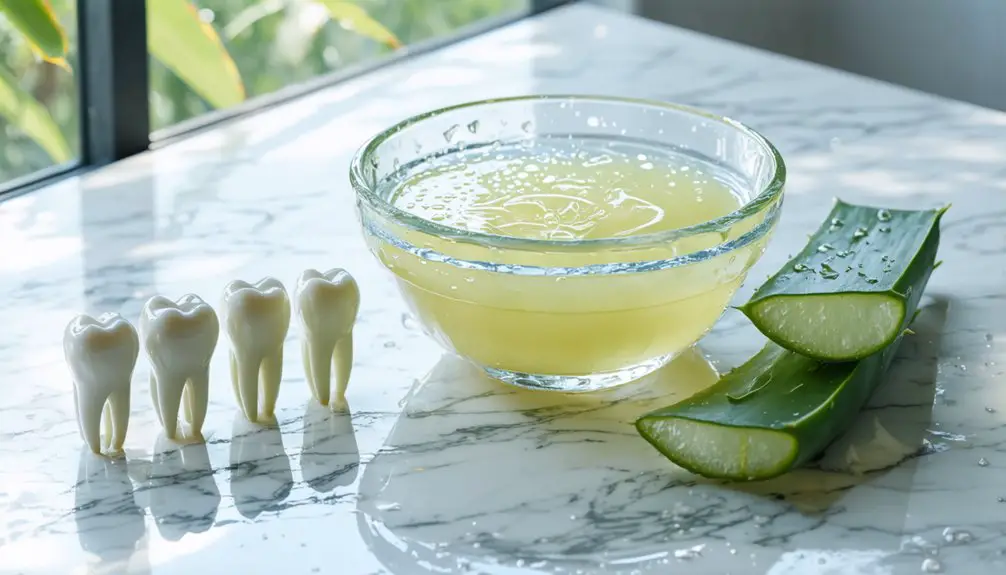You’ll love these three powerful ways to use fresh mint leaves at home: Create a relaxing bath soak by combining crushed mint with Epsom salts for muscle tension relief, steep mint leaves in hot water for 5-10 minutes to make a soothing digestive tea, or infuse mint in carrier oil for a natural skin treatment rich in vitamins A and C. These traditional plant remedies tap into mint’s anti-inflammatory and therapeutic properties – discover how to harness nature’s cooling herb.
Key Takeaways
- Create a calming bath soak by combining mint leaf oil with Epsom salts for stress relief and muscle relaxation.
- Steep fresh or dried mint leaves in hot water for 5-10 minutes to make a soothing digestive tea.
- Infuse mint leaves in jojoba or olive oil using gentle heat to create a skin-nourishing treatment.
- Add mint leaves to homemade face masks for natural cooling properties and anti-inflammatory benefits.
- Apply mint-infused oil topically to reduce skin irritation and improve circulation while regulating oil production.
Natural Mint Bath Soak for Stress Relief and Muscle Relaxation
A soothing mint bath soak offers one of nature’s most effective remedies for stress relief and muscle relaxation.
You’ll find this ancient practice combines the therapeutic properties of mint leaf oil with mineral-rich Epsom salts, creating a powerful blend for muscle recovery and mental clarity.
To create your own healing mint bath, add two cups of Epsom salt and fresh mint leaves to warm water.
The magnesium from the salts absorbs through your skin, easing physical tension, while mint’s natural compounds reduce inflammation and muscle soreness.
For enhanced benefits, consider adding complementary oils like eucalyptus or bergamot. Adding deep earth minerals can help draw out impurities while encouraging healthy circulation throughout the body.
Soak for at least 20 minutes, allowing the aromatherapeutic effects to calm your nervous system while the minerals work to restore your body’s balance. A warm bath before bedtime can significantly improve your sleep quality.
Remember to moisturize afterward to maintain your skin’s hydration.
Soothing Mint Leaf Tea for Digestive Comfort
When digestive discomfort strikes, mint leaf tea offers a time-tested solution backed by both traditional wisdom and modern science. The remarkable peppermint benefits include relaxing your stomach muscles and enhancing bile flow, which helps move food through your digestive system more efficiently.
To support your digestive health, steep fresh or dried mint leaves in hot water for 5-10 minutes. Native Americans historically relied on mint tea to treat various digestive ailments. The tea’s phenolic compounds and flavonoids work to fight harmful gut bacteria while reducing inflammation.
You’ll find it particularly helpful for easing bloating, gas, and cramping after meals. For enhanced results, consider pairing it with chamomile tea. The tea’s antimicrobial properties help maintain a healthy digestive system.
If you’re dealing with GERD, however, you’ll want to avoid mint tea as it may worsen reflux symptoms. Always serve this soothing brew warm for ideal comfort and effectiveness.
Homemade Mint-Infused Oil for Skin Care
Making your own mint-infused oil releases a treasure trove of skin-nourishing benefits, from its natural cooling properties to powerful anti-inflammatory effects.
The oil’s rich content of vitamins A and C helps nourish and protect skin cells while promoting collagen production.
You’ll harness mint oil benefits like improved circulation, regulated oil production, and natural bacteria control, all while soothing irritated skin and reducing redness.
Its anti-microbial properties make it particularly effective at reducing pimples and maintaining clear skin.
To create your own healing blend, steep fresh or dried mint leaves in carrier oils like jojoba or olive oil using gentle heat.
Store your homemade recipe in a dark glass container to preserve its potent properties. You can apply it directly to problem areas or blend it into your favorite lotions and creams.
This versatile oil works wonders for multiple skin types, helping to fade blemishes, tighten pores, and provide relief from sunburn, bug bites, and muscle discomfort while leaving your skin refreshed and naturally radiant.
Frequently Asked Questions
Can Pregnant Women Safely Use Mint Leaves in DIY Remedies?
While mint benefits include digestive ease and relaxation, you’ll need careful moderation during pregnancy. Make simple DIY mint teas but avoid concentrated forms, and always check with your healthcare provider first.
How Long Can Homemade Mint Products Be Stored Before Going Bad?
You’ll get different shelf life spans depending on your storage method: fresh mint lasts 3-5 days refrigerated, dried mint up to a year with proper storage, and homemade extracts about one year.
Which Varieties of Mint Work Best for Different Medicinal Purposes?
You’ll dig peppermint’s groovy benefits for IBS and headaches, while spearmint’s your go-to for antioxidant power. Choose watermint for blood pressure control, and eau de cologne mint for stress relief.
Can Mint Leaves Cause Allergic Reactions When Used in DIY Treatments?
Yes, you’ll need to be cautious as mint allergies can trigger serious reactions ranging from skin rashes to breathing difficulties. Always test a small amount first before applying mint-based treatments.
What Parts of the Mint Plant Should Be Avoided in Homemade Remedies?
Since roots can hold up to 70% of a mint plant’s toxic metals, you’ll want to avoid using roots, lower stems, flowers, and seeds in homemade remedies due to mint toxicity concerns.
References
- https://www.releaseyourinnerwildchild.com/blog/10-ways-to-use-fresh-mint
- https://www.azurefarmlife.com/farm-blog/fun-ways-to-use-fresh-mint-leaves
- https://www.youtube.com/watch?v=6_3aM1QkWCY
- https://dragonflytea.com/blogs/our-blog/mint-tea-benefits
- https://www.medicalnewstoday.com/articles/275944
- https://www.betterbathbetterbody.com/blogs/news/transform-your-mental-state-with-a-relaxation-soak
- https://redflower.com/products/hinoki-mint-mineral-bath-soak
- https://lakinaturals.com/blogs/journal/the-benefits-of-eucalyptus-and-peppermint
- https://www.webmd.com/diet/mint-tea-health-benefits
- https://www.healthline.com/nutrition/mint-water



